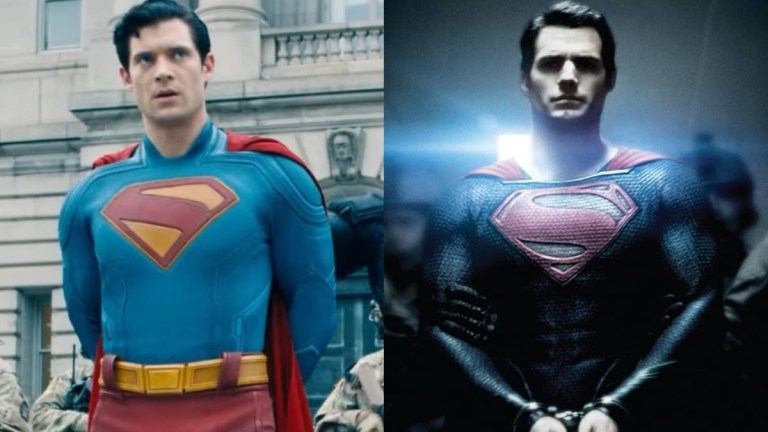The Superman Scene That Shows the Biggest Difference Between James Gunn and Zack Snyder
Both Zack Snyder and James Gunn imagine Superman getting arrested, but they take a very different approach to the scene.

This article contains spoilers for Superman.
Even if the two filmmakers admire one another much more than their respective fans would like to admit, there’s no question that James Gunn and Zack Snyder have very different approaches to Superman. These differences go beyond Snyder’s predilection for shooting muscular men as epic gods or Gunn’s habit of having characters argue about who is the dumbest. Rather they stem from contrasting approaches to superheroes in general.
And nowhere is that contrast more clear than a plot point that Superman shares with Man of Steel. Both films feature a scene in which Superman is arrested, turning himself over the U.S. government. And in both cases, it’s Superman who allows himself to be taken into custody, all part of the villain’s larger plot. Moreover both arrest scenes reveal humanity’s mistrust of Superman.
And yet, the way that Snyder and Gunn present these arrest scenes reveal how differently the two filmmakers think about the world’s first superhero.
A Superman of Sorrows
Man of Steel is about a Superman who doesn’t want to be Superman. Played by Henry Cavill, the Kal-El of that movie spends most of his time in hiding, doing occasional super deeds when they arise, but always begrudgingly, as if annoyed that the fragile humans around him have made a mess again.
To be fair, Clark comes by this attitude honestly. It was impressed upon him by his earthly parents Jonathan and Martha. The Kents may be salt-of-the-earth Midwesterners, but they’re also deeply cynical, convinced that humans will respond in the worst possible way if they learn about the alien in their midsts. So committed to this position was Kevin Costner’s Jonathan that he allowed himself to get sucked away by a tornado rather than have Clark save him.
So when General Zod (Michael Shannon) arrives on Earth and threatens to destroy the planet unless humanity surrenders Kal-El, Clark isn’t so sure about what to do. Ergo he goes to a priest in search of direction, confessing that although, “Zod can’t be trusted,” he’s also “not sure the people of Earth can be [trusted] either.”
It’s no accident that Clark and the priest have this conversation in front of a stain-glassed window depicting Jesus in the Garden of Gethsemane, praying for relief before sacrificing himself for humanity. The blocking of the shot underscores Snyder’s take on Superman, positioning Kal-El as a powerful outsider who must suffer for the sake of weak and ungrateful humans. Although the script by David S. Goyer, working off of a story he co-wrote with Christopher Nolan, includes dialogue suggesting that Superman’s sacrifice will inspire humanity to be more hopeful and trusting, very little of that optimism appears in the finished film.
Thus when Superman arrives in front of a military convoy to turn himself in, he floats above them, his muscles rippling and his cape billowing, completely unfazed by the heavy weaponry pointing at him. And although he tells Amy Adams’ Lois Lane that he allowed the humans to cuff him in order to make them feel comfortable, neither Cavill’s body language nor Snyder’s framing of the shots suggest deference. The arrest scene is all about Superman: his volition, his suffering, and, most importantly, his power. He is burdened with sacrifice for we ungrateful apostates.
Super, Human
On the surface, the situation surrounding the arrest scene in Gunn’s Superman feels far more cynical than the plot of Man of Steel. After all, it’s not the leader of an otherworldly military who demands that Superman be apprehended. It’s regular humans who have been swayed by fellow human Lex Luthor (Nicholas Hoult) that the hero means them harm. Moreover where Snyder’s Superman has done nothing to earn public mistrust, Gunn’s Superman did actually act, interfering in a global conflict without taking into consideration any other concerns.
Yet the tone of Superman’s arrest plays out very differently in Gunn’s version than in that of Snyder’s. Whereas the humans of Man of Steel never have any power over their quarry, Gunn’s Superman is vulnerable, thanks to the fact that government honcho Rick Flag (Frank Grillo) is flanked by Ultraman and the Engineer (María Gabriela de Faría). In fact, when Ultraman slams Superman into the ground while detaining him—prompting Superman to ask, “Is that necessary?”—one cannot help but think of countless online videos of real-world law enforcement arresting people with excessive force. In that moment, Superman has never been more human.
Vulnerability drives the entire arrest sequence in Superman. The background of the scene in which he decides to turn himself in is far more absurd than the one in Man of Steel, with the Justice Gang fighting a ninth-dimensional imp in place of a church window. But the tone is far more mundane, as Superman sits in a chair and mopes about being rejected by humanity, taking comfort in the company of Rachel Brosnahan’s Lois Lane and letting the other heroes handle the imp.
The banality of the scene strips away the epic tone that Snyder gives the decision. The entire world doesn’t hang in the balance of Superman’s actions, so he’s free to do what he thinks is best. And as so often happens in the movie, Superman thinks it’s best to help others. In this case, that other is Krypto, the dog that Superman thinks he can find if he’s arrested and taken to the same prison.
“He’s just a dog,” points out an incredulous Lois.
“Yeah, and not a very good one,” Superman agrees in a line that David Corenswet delivers without a hint of the self-aggrandized suffering of the Snyder version. “But he’s all alone and he’s probably scared.”
That line, almost insignificant in light of the super-battle outside and the confession of love he’s about to make to Lois, reveals everything about this version of Superman. This Superman loves people and animals who are weaker than him, and doesn’t consider them a burden. He wants nothing more than to be among them. He doesn’t desire to float above them, free of their troubles, but to sit alongside them and commiserate.
A Superman for Our Times
There’s nothing inherently wrong with either Snyder or Gunn’s interpretations. Superheroes are inherently power fantasies, so it’s not surprising that Snyder would focus so much on Superman’s power and strength, especially in relation to less powerful creatures. One need only glance at the many evil Superman riffs, such as Omni-Man from Invincible or Homelander from The Boys, to see that people are interested in stories about a powerful figure who disdains weaker beings or is corrupted by their advantage over others.
Yet it’s that very appeal that makes Gunn’s approach to Superman all the more remarkable. It’s easy to imagine an all-powerful being who disdains creatures less powerful. Heck, we hardly have to use our imagination, since we see that all the time in real life.
But the most thrilling Superman stories take advantage of the character’s absurd premise to imagine something better than what we see on the news everyday. The most fantastic part of Superman isn’t the Fortress of Solitude or Krypto the Super-Dog, or even Superman himself. It’s the idea that someone so powerful would care so much about a dog or a squirrel, would want to be around humans, with all of their weaknesses.
While Snyder’s powerful Superman has its fans, the audacity of Gunn’s kind and powerful person is clearly resonating with viewers in a way that Man of Steel no longer does.
Superman is now in theaters.
